"Hit!" As soon as the green flag goes up, the six-man crew from Hawai'i buries their blades in the still waters of Dorney Lake. Their first four strokes are deliberately slow. One, two, plant, pull. Uniform pressure, uniform power, maximum efficiency. The canoe lifts, and every subsequent grab sustains the glide. For the next seven minutes and thirty-three seconds, they focus on the finish line 1,500 meters away.
"Hut!" The paddlers switch sides. Sportscaster John Herbert's exuberant Kiwi voice booms through the loudspeakers: "This is the best of the best in each country that's being represented out there! Who is going to get themselves in the front? It's all about the turns. It's also about the straight-line speed. In the lead it's Hawaii! On the inside it's Aotearoa/New Zealand!" The spectators shout, hoisting their countries' flags.
It's the second day of the International Vaa (the Polynesian term for "canoe") Federation's (IVF) World Sprints Championships in London-the first time the event has been held in Europe. A record 369 paddlers traveled from Hawaii (which races as a separate entity from Team USA). Aotearoa/New Zealand has the second-largest delegation, with 308. Nineteen countries are in attendance-including Rapa Nui (Easter Island), with a proud party of three-all vying to take the title of best in the world. Team Hawaii's elite men's crew-Pat Dolan, Andy Penny, John Foti, Miles Orr, Jim Foti and Karel Tresnak Jr.-are looking at the moment like they have a legit shot at doing just that.
While Great Britain has a venerable rowing tradition, Polynesian outrigger canoe paddling is fairly new to the kingdom. John Foti was 15 when he first visited Great Britain-arriving, fittingly, in an outrigger canoe from France. Crossing the English Channel was the vision of Albert E. "Toots" Minvielle Jr., who established two of paddling's most illustrious races: the Molokai Hoe across the Kaiwi Channel between Molokai and Oahu, and the Catalina Channel crossing in California, which is now the course for the US Championships. Toots spent a decade planning the English Channel crossing, timing it to coincide with the bicentennial of Captain James Cook's landing in Hawaii in 1778.
"Two hundred fifty years before Cook showed up, the Hawaiians quit voyaging. No more communication with the outside world. Pau," says John Foti, using the Hawaiian word for "finished." "Then Cook shows up, reconnects Hawaii with the world, and there's a mass injection of other cultures. One hundred years later, when Toots and Duke Kahanamoku started traveling, they turned that around. They brought their aloha and their culture to the world, and they did it through their sport."
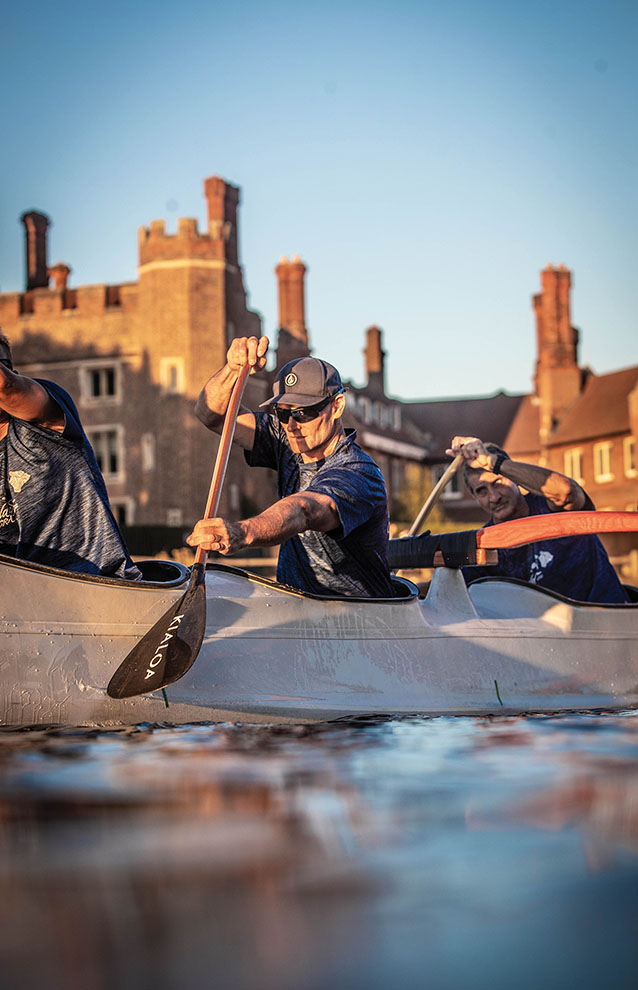 |
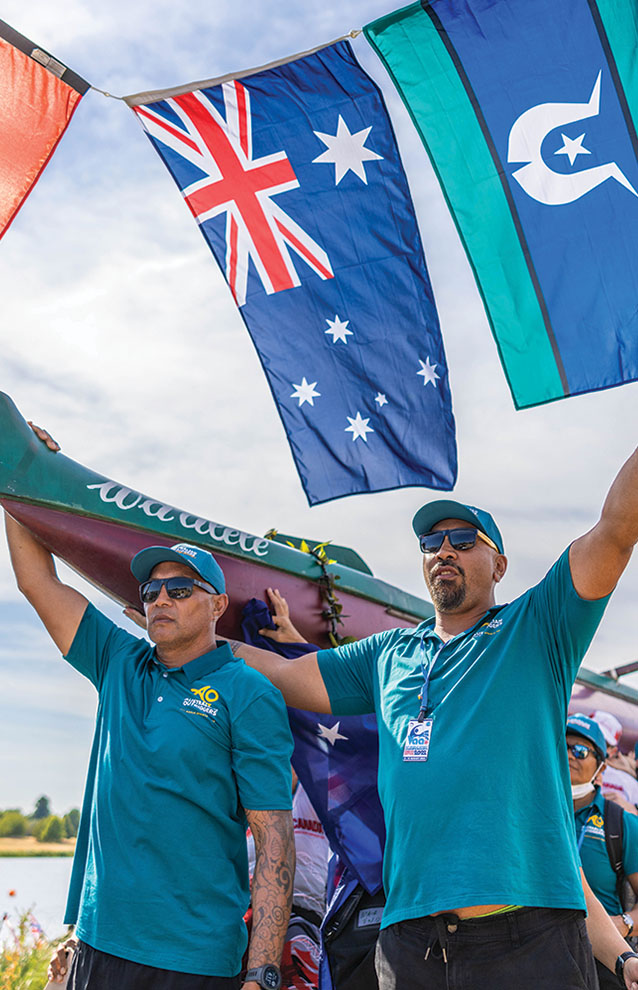 |
Opening spread, left: Team Hawaii paddles Waalele during the opening ceremonies of the 2022 International Vaa Federation World Sprints in London. The canoe crossed the English Channel in 1978, the bicentennial of Captain Cook's landing in Hawaii, and introduced outrigger paddling to Great Britain. John Foti, pictured in seat one, was part of the original crew forty-four years ago. Opening spread right: Team Hawaii elite paddlers Miles Orr, Andy Penny and John Foti pass Hampton Court Palace on the Thames. Athletes from 19 countries-including a record 369 from Hawaii-traveled to London to race at Dorney Lake. Among the three hundred paddlers from Aotearoa/New Zealand were Ngatuire Hapi (seen on the facing page) and the rest of the elite women's crew, pictured above bottom strategizing over breakfast.
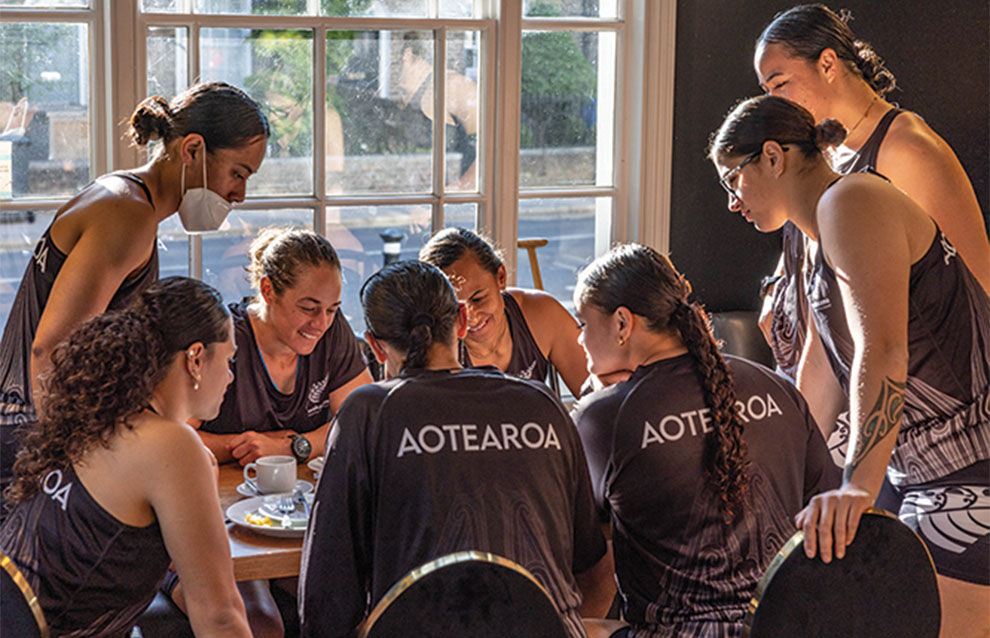
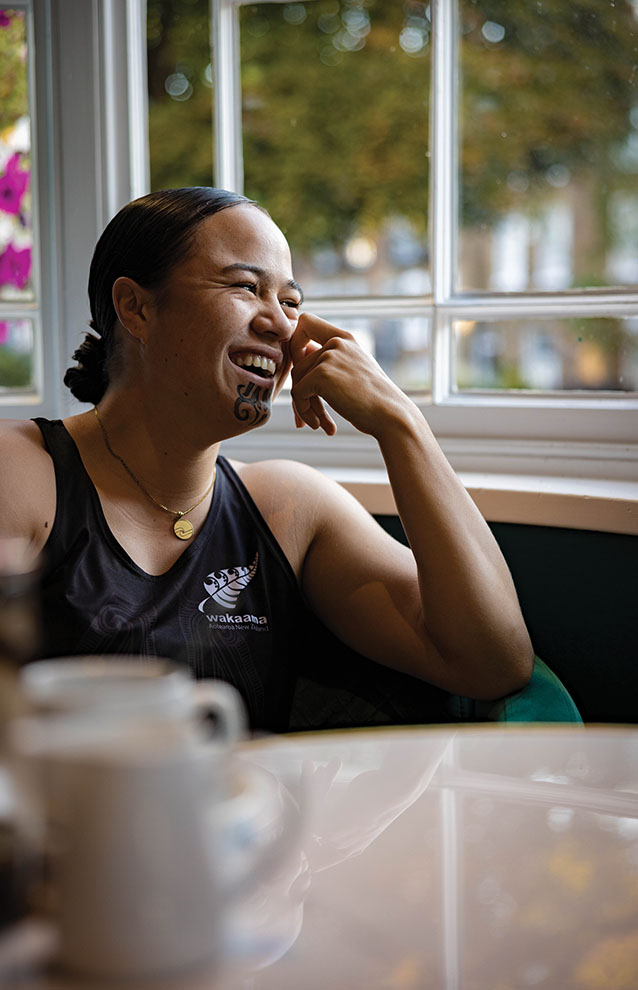
Toots chose a canoe named Waalele from Lanikai, on Oahu's Windward coast, to cross the English Channel. Foti, his late older brother Frank and their father, Philip Foti, were part of that nine-man crew. John vividly remembers the pre-dawn training sessions. "That was right after the Rocky movie came out. So it was wake up in the morning, crack two eggs in a glass and suck 'em down!" he laughs.
Waalele was shipped to Antwerp, then trucked to Calais, France. The Honolulu Advertiser, which sponsored the endeavor, issued daily updates before the departure. At 9 a.m. on June 14, 1978, the crew launched from Calais. Sporting beanies and gloves, they made their way toward the white cliffs of Dover. Every ten to twenty minutes, they swapped in a relief paddler from the escort boat -never mind jumping off the canoe into the fifty-degree water. Four hours and eleven minutes and some thirty miles of paddling later, they reached England, hugged their wives and planted a Hawaiian flag in the pebbly beach.
The crew gifted Waalele to the Captain Cook Museum in Middlesbrough, Cook's birthplace, where for the next twenty years she was displayed outside the entrance. On occasion, then-Middlesbrough Councilmember John Ferry tried to get the museum's permission to paddle her. "It's the 'canoe that flies,'" he says, referring to the English translation of its name. "How can you tie it down? They would say, 'No, it's an exhibit,' and look at me as if I'd lost my mind." When kayaker Andy White became head of the Museums Service, he called Ferry. "John, meet me in the park. I've got a job," he said. "Bring a spanner." Together they freed Waalele, and with a dedicated group of volunteers restored the long-neglected canoe. Ferry contacted Waalele steersman Frenchie Lyons and Phil Foti, who taught Ferry the fundamentals of rigging and paddling via hundreds of e-mails. They sent over a few modern paddles to replace the original blades from the 1978 crossing. Today, Waalele remains a living exhibit that has since crossed the Irish Channel and Loch Ness-and became the mother canoe for English outrigger paddling.
In 1987, paddlers from England's Royal Canoe Club eager to tackle the Kaiwi Channel met Toots in Hawaii and told him, "We can't paddle in England, because we have no canoe." He gave his blessing to use Waalele. In 1988 the RCC made a mold from Waalele to build Waalele Keiki-and outrigger paddling in Great Britain was born.
Forty-four years later, John Foti is at the World Sprints opening ceremonies, paddling Waalele across Dorney Lake with her keiki (child) gliding behind her. Ferry sits behind John, overjoyed to finally meet members of the Waalele ohana in person. The Fotis (John, younger brother Jim and sister Kathy) present Great Britain Outrigger with one of the original paddles made by Toots himself.
"Cook and Duke had instant notoriety, but Toots had none. He did all his work under the radar," John Foti says. "He seeds London, and here we are-because Toots' indomitable spirit pushed through."
The first World Sprints was held in 1984 at Long Beach Marine Stadium. It was the natural progression of racing as the sport reached new shores. Organizers in Tahiti, Hawaii and California set up a governing body, the International Polynesian Canoe Federation, which later became the IVF. In 1982 paddler Don Lee (who's here in London to participate in several Men's 75 division races) met with Arpad Csanadi, the Hungarian soccer legend who oversaw venues for the International Olympic Committee. Csanadi's approval would help sanction a world championship event.
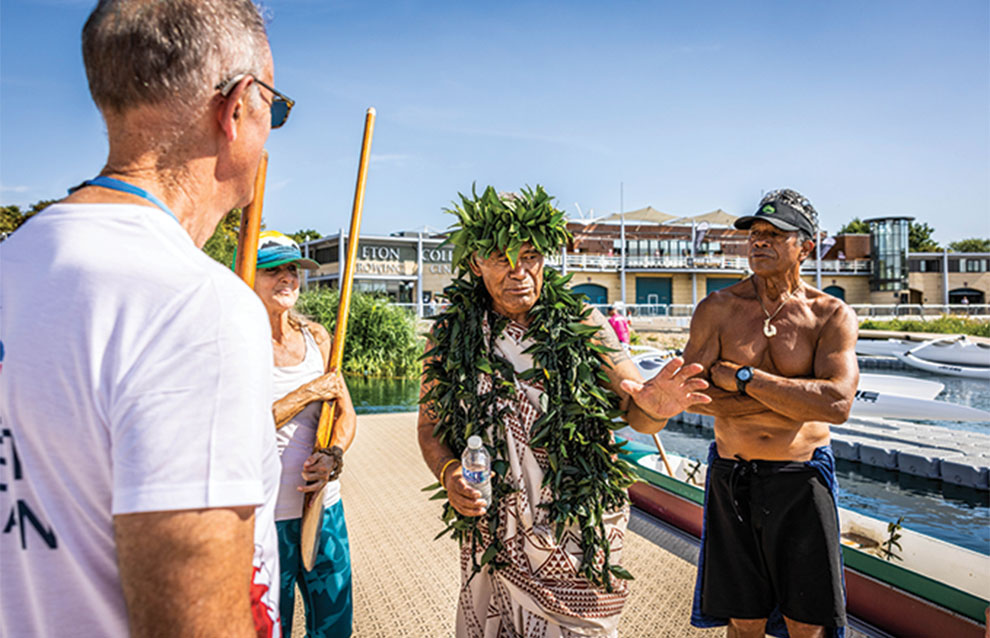
Maui's Kimokeo Kapahulehua blesses the canoes at Dorney Lake (above). On the facing page, Sean Herbert, Conan Herbert and Tupuria King of the Aotearoa/New Zealand club Herberts on Tour brought home gold medals in the Open Men's V6 1,500-meter and 500-meter races. (BELOW): Nappy Napoleon, Sam Rodrigues and Cappy Sheeley of Honolulu's Anuenue Canoe Club prepare to race in the inaugural 80s age division.
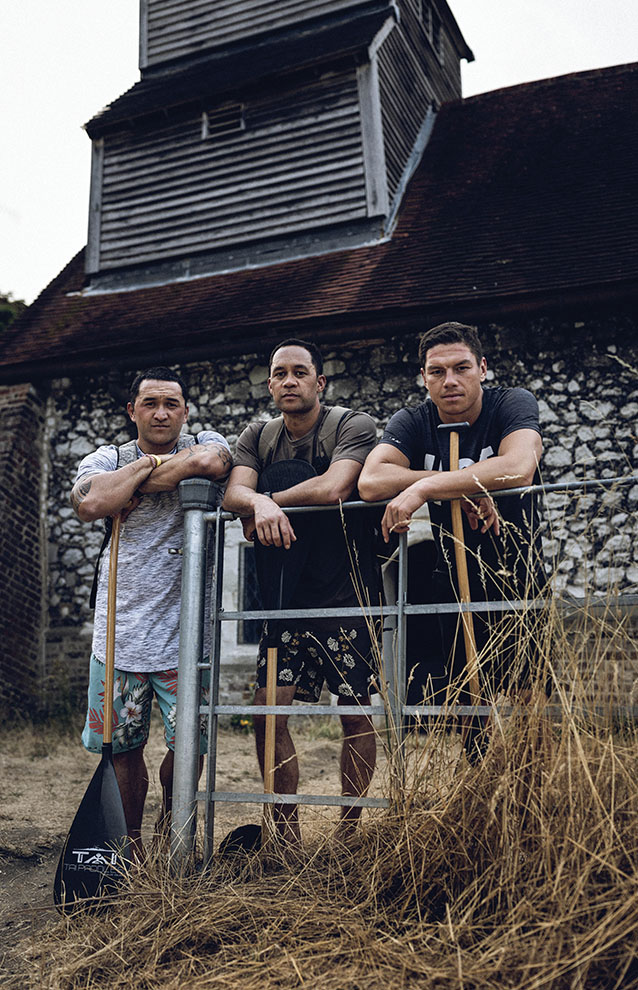
Lee remembers popping a video into a VCR and narrating the action: a regatta featuring the freshmen men's division-six koa canoes with chiseled and bronzed paddlers, stroking furiously toward their turn flags. "When Dr. Csanadi saw the turn, he jumped up and bounced back," Lee recalls of the moment when Csanadi saw paddling as a viable spectator sport. "He put his briefcase on the chair-you know, the old-style briefcase that goes 'click-click'? He reaches in, hands me his business card, and says, 'Your federation may go ahead and apply for status.'"
Since then the federation has grown to thirty-five member countries, including unlikelies such as Sweden, Singapore and Panama. Para Vaa-adaptive paddling for disabled athletes-has also been included since 2002. In Tokyo last year, one-man, or V1, racing, made its debut in the Paralympics, vaulting the sport to the Olympic stage.
This year's championships take place at Eton College's Dorney Lake, the world-class rowing venue of the 2012 Summer Olympics. It's eight circuitous miles from Windsor Castle, where at the moment the Queen's Platinum (and, unbeknownst to all, final) Jubilee is in full swing. A heat wave has sent temperatures soaring, prompting officials to set up sprinklers in front of the pre-race chutes. The schedule includes a mind-numbing 383 races, grouped by gender, age, distance (250, 500, 1,000 and 1,500 meters) and vaa type: V1s, six-man V6s and twelve-man V12s.
Throughout the day, race director Cameron Taylor bicycles around the venue past the athletes' tents, stage, vendors, food trucks, boathouse, medical tent and media center, relieved that all pieces are in place. COVID had delayed the green light for World Sprints, so organizers had only six months to pull off an event that typically takes two years of planning. Taylor, who also serves as CEO of Great Britain Outrigger and IVF treasurer, embraced the opportunity to showcase cultural traditions-including hula and ukulele performances and canoe rigging demonstrations-as part of the festivities. "It is the Pacific people's sport. We're just caretakers of it, and we want to perpetuate the culture," he says.
Having London as the host builds momentum for paddling in Europe, says IVF President Lara Collins. "If it was in the Southern Hemisphere, I'm not sure Sweden, France and Germany would have come. Here, because it's in their time zone, their friends at home can also watch it," she says. "You can't always wait for people to come to you. Sometimes you have to take it to them in order for them to see it."
Taylor agrees, nodding to the fleet of Matahinas, the Tahitian-built V6s moored to the docks. These official 2022 race boats-twenty-four of them-will remain in Europe after the event, and Taylor believes they will enable the number of clubs in Great Britain to double to twenty-two by the end of next year. (In 2018 there were only five.) "When New Zealand got World Sprints in 1990, they started from scratch as well," he points out. "Look at them now: three hundred-something strong here-and they're winning."
Tahiti, paddling's racing powerhouse, has always dominated flatwater sprints; with their absence from the event due to a reluctance to travel during the pandemic, Aotearoa/New Zealand is now the favorite. Modern V6 paddling in Aotearoa is an emblem of cultural pride, promoted by Waka Ama, a national organization that receives government funding and fosters high school paddling. Their first canoe club was established in 1985, and less than a decade later they matched Tahiti's medal count at the 1994 World Sprints.
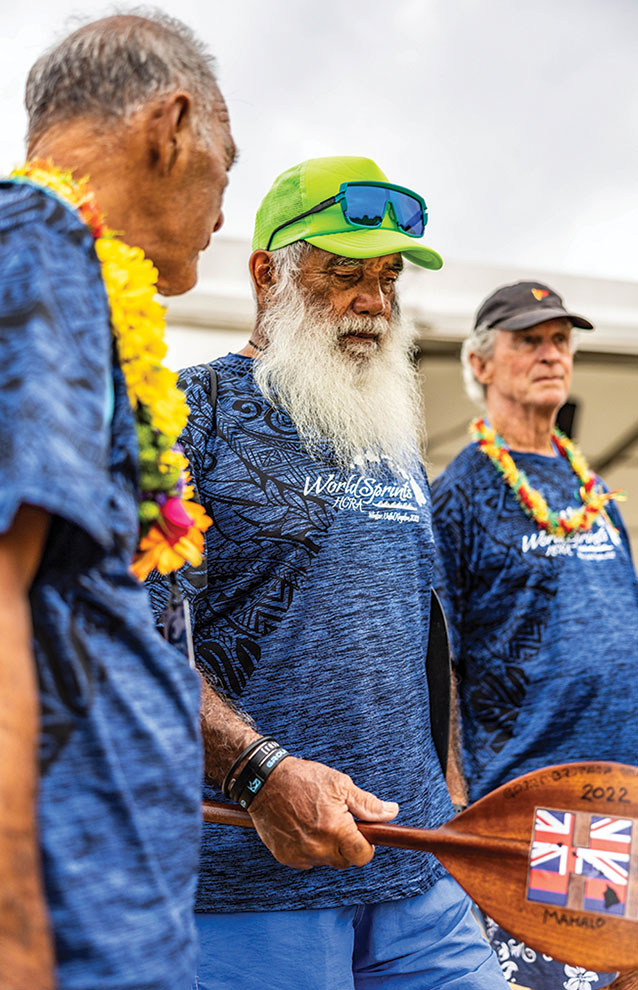 |
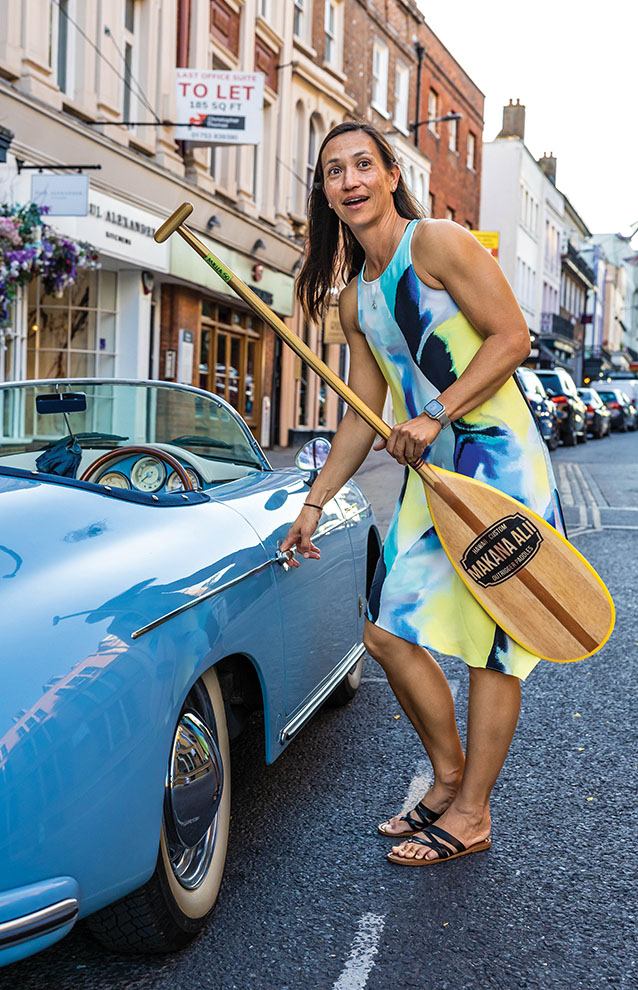 |
(LEFT) The Herberts on Tour crew walks through fields of gold near Dorney Lake, located in the countryside thirteen miles from Heathrow Airport. (RIGHT) For Hawaii paddlers, navigating the streets of Windsor, where everyone drives on the left, proves a greater challenge than steering an outrigger canoe in fresh water 7,200 miles from home. Steerswoman Anella Borges of Hawaii's elite women's crew, which swept silver medals in the V6 events, ready to take a spin.
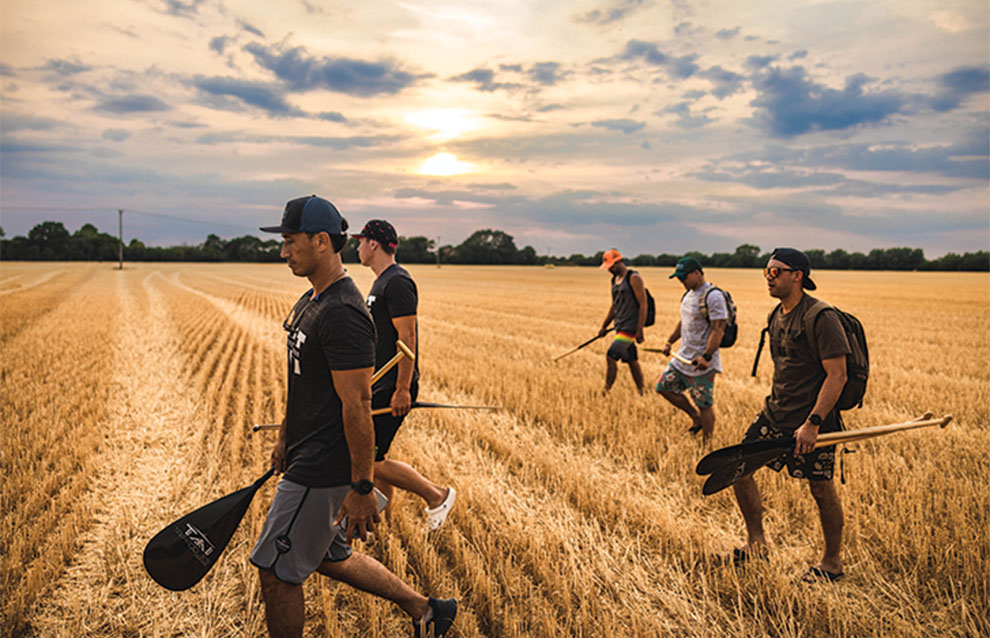
"World Sprints is the pinnacle," says Kiwi Campbell, head coach and paddler for Aotearoa's elite women. "It gives us an opportunity to race other countries, to size up each other's ability." Their team starts preparing as fall turns to winter, when greater motivation is required to get in the water daily. They train together every two weeks, some paddlers traveling half a day from opposite ends of the country. "Financially it's a huge commitment, and geographically it has its challenges, but we make it happen," Campbell says. "Once we make the team, we want to come here. We want to represent our country well."
"Our being here is the result of sacrifice from families and friends who make a lot happen behind the scenes. We've got a job to do, and that is to come and race," says Conan Herbert of the Herberts on Tour open men's crew. They go on to win both the Open Men's V6 races, securing two of Aotearoa's eventual forty-four gold medals. The elite women also follow through with a gold-medal sweep. Each time Aotearoa takes the podium, they perform a haka, a Maori war dance. It's one of the most visceral rituals of the event.
While Aotearoa might be leading the medal count, Team Brazil wins the award for enthusiasm. Brazil is home to the fastest-growing community of outrigger paddlers in the world. Their contingent of 196 brings flair to the event, with impromptu displays of capoeira (at once a martial art and dance), fervent flag-flying and avid jersey-trading. "I started paddling because my wife's son is a paddler," says Marcelo Cunha, head coach of Kahu Moana Vaa in Vila Velha north of Rio de Janeiro. "I wondered what he was doing, waking up early so much," he laughs. "Then we started paddling. The love came in the first paddle, and it kept going, and it's the love of our lives now." A year ago Cunha stopped saddling horses and started a canoe club on the beach a hundred meters from his front door. "I changed all of my life. I used to weigh 110 kilos. Now I'm 88. Life becomes easier in paddling." His club quickly grew to ninety paddlers, six of whom are here in London.
Team Brazil's first V6 arrived in 2000. Today they have canoes from Hawaii and Tahiti, and they're also making their own. The sport spread like wildfire, especially after COVID, says Cunha. Eight canoe clubs now share the five-hundred-meter stretch of beach with Kahu Moana. In the metropolitan area of Vitoria in southeastern Brazil alone, he says, there are forty clubs. All of Hawaii, by comparison, has just under eighty.
"We Brazilians love the beach, love the ocean, love the wildlife. We love the sun, we love to go out, see people. We have passion for the canoe, passion for the tradition. Paddling is a beautiful motivation for us," he says, putting into words the energy that Team Brazil exudes all day, every day. "Everybody here is looking for the same thing. There's no fighting. There's no excuses. Just fun moments together. You know the aloha spirit? I say this is the aloha spirit."
"As they come into this turn, watch, watch, look, learn!" shouts Herbert, whipping up excitement over the PA. "Hawaii gets the front of its canoe around. Look at it spin on its axis! Off go Hawaii! They're away! Can anyone respond? Can anyone pull them back in?"
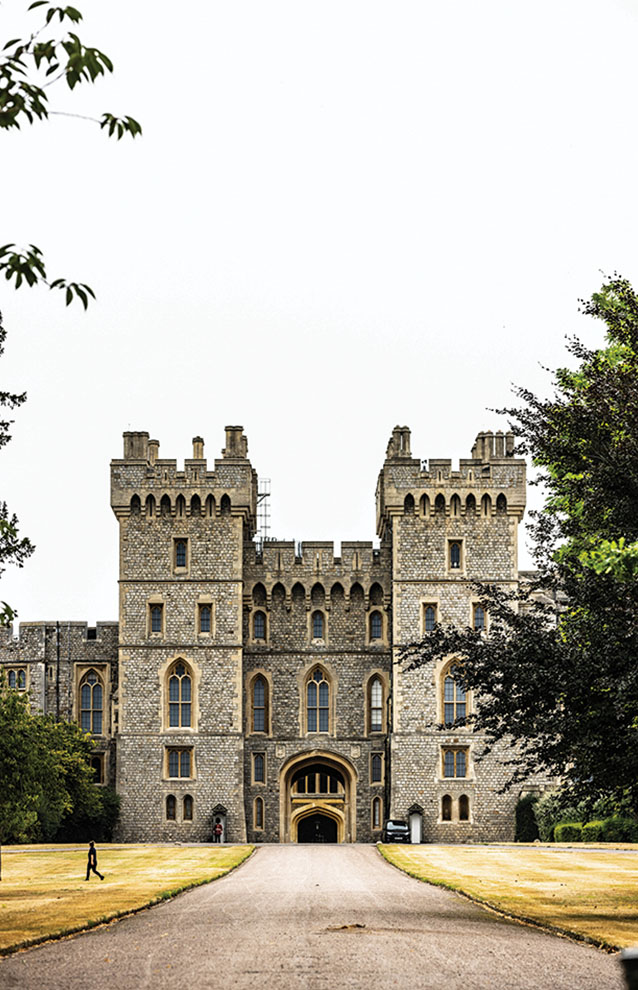 |
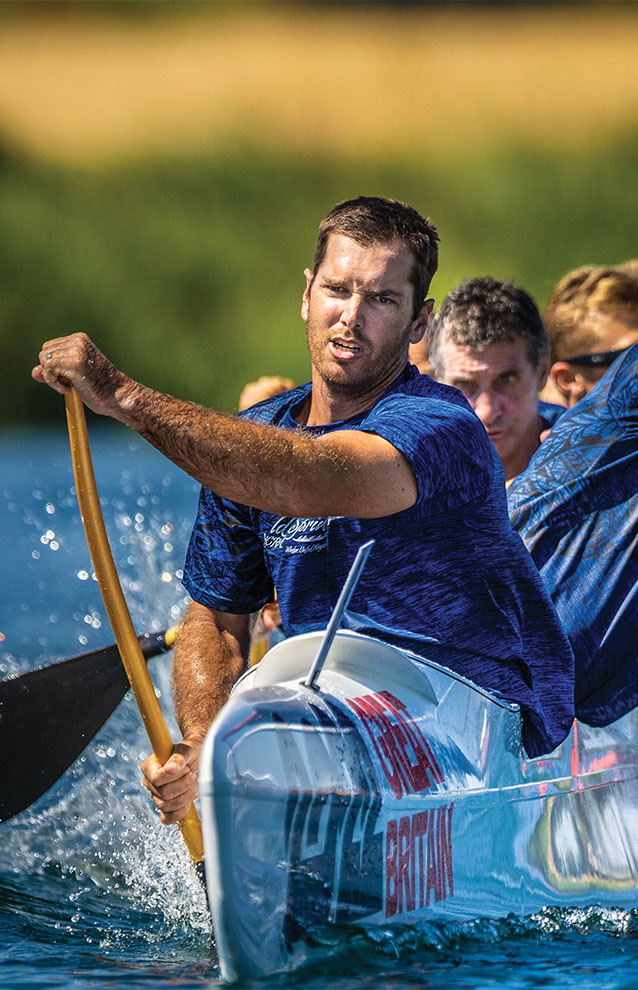 |
(LEFT). On the facing page: Pat Dolan positions his paddle to help maneuver the canoe around one of five turns as Hawaii's elite men hammer their way to a gold medal in the 1,500. Having two of Hawaii's best steersmen in the canoe-Jim Foti in seat five and Karel Tresnak Jr., in seat six-gave their crew a critical advantage in nailing the turns. They held off Aotearoa/New Zealand by five seconds in the final. "Every time, we're giving 100 percent," says Andy Penny in seat two. (BELOW) Team Hawaii's elite women cruise down the "Long Walk" that leads to the gates of Windsor Castle
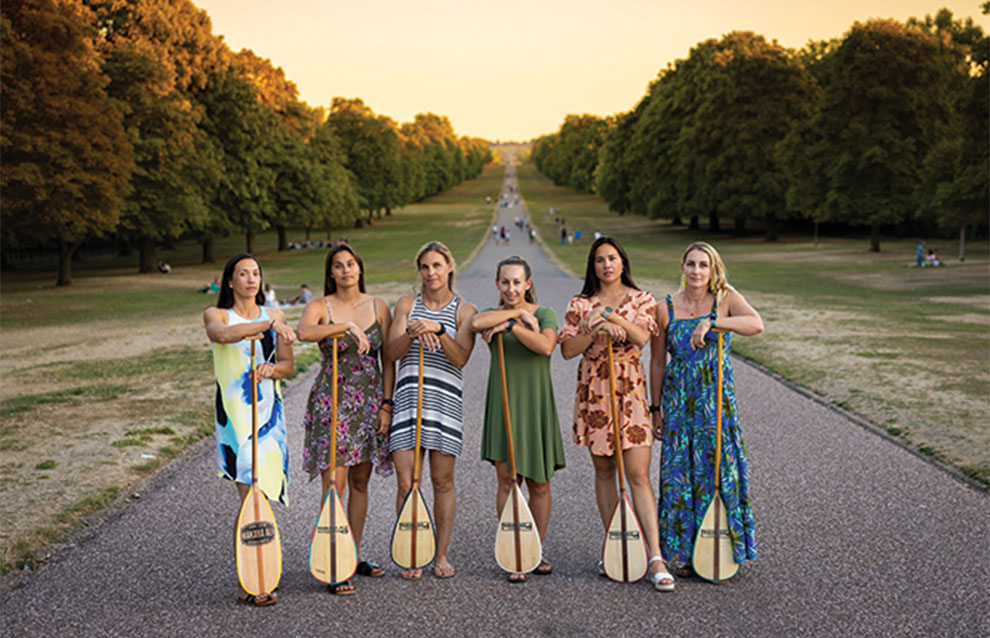
This elite men's crew, half of them stalwarts from Lanikai Canoe Club, has collectively earned fourteen Molokai Hoe (V6) victories and 65 state regatta titles-one of the most decorated and dynastic crews Hawaii has ever fielded. Even more exceptional: Their ages span four decades-Orr is 21, Dolan is 34, Tresnak and Penny are in their forties and the Foti brothers in their fifties. Penny points out that Orr might have been in diapers the last time the other five in this crew paddled together. They comb their memory banks, guessing it was roughly sixteen years ago, when Dolan was still a teenager. "I can't remember," Penny says. "But we won!" Despite their age differences, what they share-experience, synchrony and impeccable form-will determine whether they paddle away with the 1,500-meter gold.
"A sprint for me is a five hundred," says steersman Tresnak. "That's two minutes. You make one mistake, let alone two or three? You're done. The guys are too good and the race is too short. But a fifteen hundred? You can't just go crazy; you have to adjust." The crew also had to adjust to an unfamiliar canoe. During practice runs they found their edge with their Matahina. "We realized we hate turning it," says Tresnak. "But I'm like, 'Everybody hates turning it more than we do.' After we did it a few times, it wasn't that bad. Actually, it's easier in a way, because it's in slow motion. It takes forever, but once we got it wired, it was easy."
Team Hawaii could have floated any number of legitimate excuses for a losing performance-fatigue from flying across two oceans, airlines losing paddles (luckily, Palafamala paddle maker Cameron Jacome was on-site with spares), the oppressive heat, the constant noise of planes taking off and landing at nearby Heathrow Airport. "At first our paddlers were out of their comfort zone. It's the farthest we've ever traveled for a race," says Kaili Moikeha, head of the Hawaiian Canoe Racing Association (HCRA). "But now that the racing has started, everybody's ready to go. They're excited. They're focused." Moikeha and staff are paying particular attention to logistics this year because HCRA will host the 2024 World Sprints in Hilo, where they're expecting almost twice the turnout.
Tresnak, who has won more Molo Solos (solo races across the Kaiwi Channel) than any male in history, offers some insight into their success. "You have to be able to self-critique. Every time you get in the boat, you have to think you're the weakest link. You have to go, 'I'm here to make a difference and do better.'"
"Every time, we're giving 100 percent and dying for each other," Penny adds. "I want to win. So next time someone asks when we last raced together, I can say, 'I don't know. But we won!'"
It might sound a touch melodramatic to say you'd die for your crew, but it actually almost happens. As the Namolokama 60s men from Kauai win their thousand-meter semifinal, Vic Allen, 65, goes into cardiac arrest. "Right after we crossed the line, I held up my paddle, and I was looking straight up, to the heavens," Allen says, describing photos of what he now calls "the incident." The crew linked hands to congratulate each other, but Allen was slumped forward. Paramedics at the dock worked to resuscitate him for a tense thirty minutes. Native Hawaiian cultural practitioner and paddler Kimokeo Kapahulehua led a pule (prayer). Paddlers from nineteen countries all raised their paddles, praying in many languages. Upon regaining consciousness-after having been dead for some eight to fourteen minutes, the paramedics said-Allen's first words were, "Did we win?"
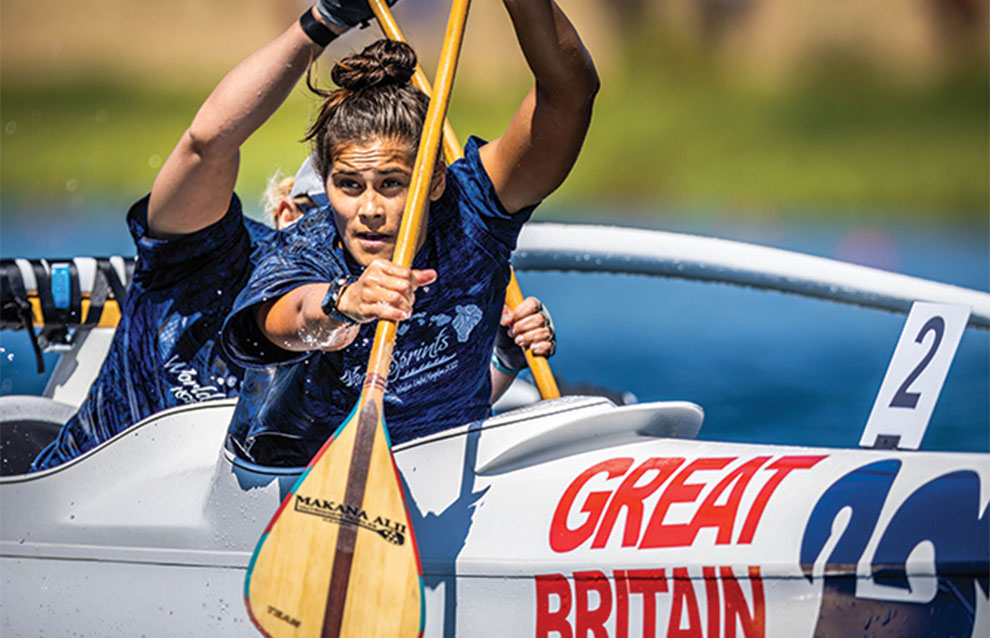
(ABOVE) Nahoku Keala, stroker for Hawaii’s elite women, sets the pace as her crew pulls off a silver-medal performance in the V6 1,500-meter. (BELOW) Months of intensive training pay off for Akayshia Williams of Aotearoa/New Zealand as she celebrates her decisive victory in the Open Women’s V1 500-meter sprint.
Allen, says he feels blessed. "They were all in unison. Lokahi, unity. Something we're always looking for in the canoe. Our guys always say, 'You know why we win? We're not that good. We're OK.' What we have is lokahi. We love each other. You know, when you're going a long distance and you see the canoe sitting down, and you go, 'I gotta give a little bit more,' because maybe Braddah Legs needs a break. So I need to push a little harder. That's what we have in the canoe. And I think that's what was there on the docks when I was taken away."
If one were inclined to see divine choreography in the dance of life, one might say Allen's heartstopping performance was a stroke of providence. Allen, who is blind and relies on his teammates to be his eyes, was subbing for fellow crew member Jack Edgehill, who'd contracted COVID. With Allen, the team managed to qualify for the finals-just in time for Edgehill to clear quarantine and jump into the canoe. They had their world cut out for them: Namolokama's qualifying time was almost five seconds behind that of the fastest qualifiers, a team from Calgary. Following an encouraging call from Allen in the hospital. the crew huddled up before the start of the race. "One, two, three, 'Vic!' and it felt like the ground shook," says steersman Jeff McBride. Namolokama brought home the gold, winning by exactly one second.
"The champion of all time is Father Time," muses John Foti. And yet the kupuna (seniors) competitors would make you believe otherwise. Races 112 and 118 are standouts: Three double-hulled canoes of 75-plus-year-old men and two double-hulled canoes of 75-plus women-all Hawaii crews-race a 500-meter final. Their canoes are light on the water and heavy in experience, boasting crews of venerable watermen and waterwomen who have made invaluable contributions to their communities through paddling.
Steering one of those kupuna canoes is 81-year-old Joseph "Nappy" Napoleon, who has likely crossed the Molokai Channel and competed at World Sprints more than anyone. He's traveled and paddled with his stalwart crew for decades. They share a good-natured camaraderie: "My mouth is still sweet when I'm behind yelling at them," he jokes. Napoleon pushed the IVF to include the older age bracket so that octogenarians don't have to compete against septuagenarians. Two clubs from Anuenue Canoe Club, which Napoleon and his wife Anona founded in 1983, are the only contenders in the first-ever 80s V6 division, and Napoleon goes on to win silver in the 80s V1 250-meter race.
Fellow Anuenue paddler Sam Rodrigues, 82, explains that including the upper age divisions helps clubs sustain membership, which perpetuates the tradition. "If young people see-Ho, he's that old? I can paddle at that age?' It's like ... forever!" Sam laughs. "And then they bring their kids."

In the media room, Hawaii Public Radio reporter Kuuwehi Hiraishi sits down with 20-year-old Leimomilani Naone from Waianae to talk story about her World Sprints experience. They speak in olelo Hawaii (Hawaiian language): "No na poe e ae manao lakou he poe Amelika oe, aka aole ma anei. Aia makou ma lalo o Hawaii ma anei. He mau poe Hawaii e hoe ana no Hawaii a he mea hoohauoli i ka puuwai." Hiraishi translates: "Naone says that everywhere else she's considered American, but not here. Here she paddles for Hawaii, and that makes her proud."
Hiraishi interviews 83-year-old Hawaiian activist Jimmy Naniole, who has been paddling since he was 18. "I see your contribution to the lahui [nation], to my generation," she tells him, "all of that embodied in this one who keeps on coming out here, taking care of his kino," his body. "Because it's not mine," the Keaukaha Canoe Club paddler says. "It's part of the land, you know what I mean? I'm not taking care of kino. I'm taking care of a relationship that is a function of and a kuleana [duty] to the aina [land] and the wai [fresh water], the kai [sea]. And the wa'a is a vehicle that allows us to be with both."
"Here they go!" Herbert calls. "It's coming down to this last turn. Look how close their ama [outrigger] is to the turn flag! Hawai'i are gone! They're out of here! There are no tidal waves, no tsunamis coming to do anything. They're not going to relinquish this lead!" The Lanikai men cross the finish line in 7:33. "Here in Dorney Lake, in 2022, you are watching World Champions, Hawai'i!"
In the canoe, fists pump with elation. The sea of blue jerseys on shore erupts in celebration at Hawaii's sole elite gold medal. Team Hawaii's elite crews leave with fourteen medals, ranking fourth behind Aotearoa/New Zealand, Canada and Great Britain. Notably, Hawaii's elite women's crew from Outrigger Canoe Club wins silver medals in each of its races. (In October, five of the six women in this crew also go on to race in the wahine division of the prestigious Hawaiki Nui in French Polynesia. Paddling against the world's best, Outrigger finishes the thirteen-mile race across the lagoon of Raiatea eighteen seconds ahead of Tahitian crew Teva to become the first Hawaii women's team to win since 2001.) In the club division, Hawaii places second overall, with fifty-one medals.
From the podium, the Team Hawaii/Lanikai men gaze at the crowd as the Hawaiian flag is raised and "Hawaii Ponoi," Hawaii's national anthem, plays over the speakers. "When we show up we want to win, but more importantly, we want to show up," Tresnak says. "Especially when we're representing Hawaii"-a place where canoes carved the paths of history. "It's the heart of home."


